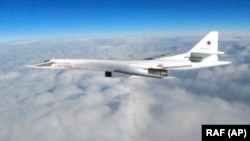U.S. and Canadian fighter jets were scrambled to escort two Russian nuclear-capable bombers away from the North American coastline in the Arctic region, military officials say.
The North American Aerospace Defense Command (NORAD) on January 26 said two Russian Tu-160 Blackjack strategic bombers were identified entering an area patrolled by the Royal Canadian Air Force on January 25.
It said two U.S. F-22 and two Canadian CF-18 fighter jets flew to the location and escorted the Russian bombers out of the zone. The U.S. jets flew out of a base in the U.S. state of Alaska, the military said.
The reports did not specify the exact location of the encounter. The military monitors air traffic in the Alaska Air Defense Identification Zone, which extends 320 kilometers off Alaska.
Russian state-run TASS news agency on January 27 cited U.S. officials as saying the Russian jets did not enter “sovereign territory.”
It quoted the Russian Foreign Ministry as saying the two strategic bombers “completed a scheduled flight over neutral waters of the Arctic Ocean [and] practiced refueling” during a 15-hour flight.
There were no reports of conflict between the Russian and the U.S. and Canadian warplanes.
"NORAD's top priority is defending Canada and the United States,” General Terrence J. O'Shaughnessy, the NORAD commander, said in a statement.
“Our ability to protect our nations starts with successfully detecting, tracking, and positively identifying aircraft of interest approaching U.S. and Canadian airspace."
NORAD, a combined U.S.-Canadian command, uses radar, satellites, and aircraft to monitor aircraft entering U.S. or Canadian airspace.
U.S. officials have reported several incidents of U.S. and Canadian jets scrambling to intercept Russian warplanes and escorting them from the region.
In September 2018, the Pentagon issued a protest after U.S. Air Force fighter jets intercepted two Russian bombers in international airspace west of Alaska.
In that incident, the jets followed the Russian craft until they left the Alaska Air Defense Identification Zone.
In April 2017, Russian warplanes flew near Alaska and Canada several times, prompting air defense forces to scramble jets after a two-year lull in such activity.
The Russian Defense Ministry confirmed the incident, saying the bombers were performing "scheduled flights over neutral waters" when they were escorted by the U.S. F-22 warplanes.
Encounters between Russian and NATO warplanes in various parts of the world have increased in recent years as Moscow demonstrates its resurgent military might.
Moscow said it scrambled a jet in June 2017 to intercept a nuclear-capable U.S. B-52 bomber it said was flying over the Baltic Sea.









